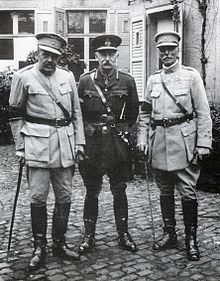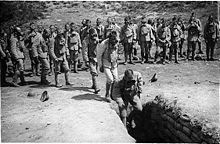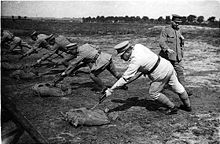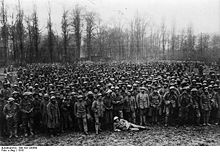- Portuguese Expeditionary Corps
-
Portuguese Expeditionary Corps 
CEP soldiers loading a Stokes Mortar.Active During World War I, 1917-1918 Country Portugal The Portuguese Expeditionary Corps (Corpo Expedicionário Português or CEP) was the main military force from Portugal that participated in the First World War. Portuguese neutrality ended in 1916 after the seizure of German merchant ships resulted in Germany declaring war. The expeditionary force was raised soon after and included around 55,000 soldiers.
Contents
Background
Main article: Portugal in World War IAt the outbreak of the First World War, Portugal had declared its neutrality. The country remained neutral until 1916, though occasional skirmishes between Portuguese and German colonial troops occurred in Africa. In March of 1916, the Portuguese government seized a number of merchant ships belonging to the Central Powers which were anchored in Lisbon; the German government took this as a hostile act and declared war.[1]
The government announced it would raise an expeditionary force to fight on the Western Front, with the first units being raised by July. In early 1917, the force was split into two elements:[2]
- Portuguese Expeditionary Corps (Corpo Expedicionário Português, or CEP)
- Independent Heavy Artillery Corps (Corpo de Artilharia Pesada Independente, or CAPI)
The CEP was an infantry force of two divisions (a single army corps) with a nominal strength of about 55,000 men. The CAPI, meanwhile, was an artillery force of nine batteries of heavy artillery, manned by Portuguese gunners with artillery provided by France and the United Kingdom. The CEP would fight under British control as part of First Army, whilst the CAPI would fight under French control.[3]
Combat service
 A monument to the dead of the First World War in Coimbra.
A monument to the dead of the First World War in Coimbra.
The CEP was shipped to France in early 1917, where the first groups received training in trench warfare and were equipped with British small arms.[4] The first units began to deploy in May, and a sector of the frontline was fully held by the CEP by November; by the end of October, just under 60,000 troops had been sent to France.[5]
Morale was low through the winter of 1917–1918, partly due to bad weather and partly due to a perception among the soldiers that there was no reason for them to be in France. However, the major problem was a gradual loss of manpower; by April 1918, 10% of the CEP's strength had become casualties, due to the constant attrition of front-line service, and almost half of the officers were missing. Replacements were not forthcoming, and so units became severely understrength; in order to cope, men were routinely denied leave, and units kept in the frontline for up to six months at a time, further lowering morale.[6]
In April 1918, mutinies began to be reported from amongst the men, and the decision was taken to pull the CEP out of the frontline and replace it with British units. On 6 April, the 1st Division was pulled back,[7] with the British 55th (West Lancashire) Division extending its lines southwards to fill part of the gap and the 2nd Division taking up the remaining section of the line. The 2nd Division itself, now holding twice the normal divisional frontage, was scheduled to withdraw on 9 April and be replaced by two British divisions. That morning, however, the Germans opposite launched a major attack, which would develop into the Battle of the Lys.[8]
Eight German divisions attacked the Portuguese line, with a manpower of around 100,000 men against the 20,000 Portuguese. The result, despite stubborn resistance, was a foregone conclusion; the 4th Brigade, defending the northern sector, was overrun by 11am, and the 5th Brigade HQ in the central sector fell at 1pm. The bulk of 2nd Division ceased to exist as a fighting formation, retreating in such disarray that the divisional HQ had to relocate twice on 9 April.[9]
The mounted reserve held by XI British Corps[10] was released to support the remaining units, and joined two Portuguese battalions on the south end of the line, which held their ground until the next morning and prevented any further advances to the south or south-west;[11] the main gap in the line was filled by the deployment of the British 50th (Northumbrian) Division and 51st (Highland) Division.[12]
It was later calculated that the CEP lost 400 dead and around 6,500 prisoners on 9 April, a third of its forces in the front line.[13] The — overwhelmingly negative — historical verdict on the battle was epitomized by the comment that the Portuguese "ruined Ludendorff and saved their allies by running away";[14] whilst the German advance was superficially impressive, especially to begin with, it quickly lost momentum and stalled.[15] However, it is likely that the collapse would have happened to any unit, not merely the weakened and demoralized Portuguese; British troops in a similar position the previous month, in Operation Michael, had been overrun just as quickly.[16]
The remnants of the corps were withdrawn for rear-area pioneer and security duties, though the 1st Division would later be returned to the front line for a short period. By the armistice in 1918, the CEP had lost 2,160 dead, 5,224 wounded and 6,678 prisoners — 14,000 casualties out of an establishment of 60,000.[17]
Composition
- 1st Division
- 1st Brigade
- 2nd Brigade
- 3rd Brigade
- Division troops
- 3 x Heavy Machine-guns battalions
- 3 x Artillery battalions
- 3 x 152 m mortar batteries
- 236 mm mortar battery
- 3 x Miners and Sappers companies
- Telegraph Company
- Motor battalion
- 2nd Division
- 4th (Minho) Brigade
- 5th Brigade
- 6th Brigade
- Division troops
- 3 x Heavy Machine-guns battalions
- 3 x Artillery battalions
- 3 x 152 m mortar batteries
- 236 mm mortar battery
- 3 x Miners and Sappers companies
- Telegraph Company
- Motor battalion
- Corps troops
- Cyclist battalion
- Miners battalion
- Rearguard Base
- Forces under direct command of the British 1st Army:
- Railway Battalion
- Heavy Artillery Corps
Notes
- ^ Rodrigues
- ^ Rodrigues
- ^ Rodrigues
- ^ The Portuguese Army used the Mauser-Vergueiro rifle, with a 6.5mm cartridge; it was felt that supplying the ammunition for this would cause a logistical problem, and so the units received the British Lee-Enfield.
- ^ Rodrigues
- ^ Rodrigues
- ^ Rodrigues
- ^ Liddell Hart, p.402
- ^ Rodrigues
- ^ The 1st King Edward's Horse and the 11th Cyclist Battalion of the Army Cyclist Corps
- ^ Liddell Hart, p.404
- ^ Rodrigues
- ^ Rodrigues
- ^ Liddell Hart, p.401
- ^ Liddell Hart, pp. 405–6
- ^ Rodrigues
- ^ Rodrigues
References
- Liddell Hart, B. H. (1997). History of the First World War. Papermac. ISBN 0333582616.
- Rodrigues, Hugo. "Portugal in the Great War". France at War. http://www.worldwar1.com/france/portugal.htm. Retrieved 2008-12-21.
Categories:- Military units and formations of Portugal
- Portugal in World War I
- Corps of World War I
Wikimedia Foundation. 2010.




